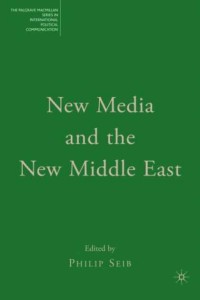|
Reviewed by Pam Meister, researcher and editor of Familysecuritymatters.org Since the U.S. invasion of Iraq in 2003, and the resulting democratic restructuring of that nation’s government, much attention has been paid to effort to bring democracy to the Middle East in general. New communications are seen by many to be a vital tool in that process. Yet despite the growing popularity of the Internet, Philip Seib—a professor of journalism and public diplomacy at the University of Southern California—warns that it “should not be viewed as a cure-all by advocates of democracy” in the introduction to New Media and the New Middle East. The book, an edited collection overseen by Seib, gathers essays by young Arab scholars, as well as a few Israelis and Westerners, addressing the role of new media—principally satellite television and the Internet—in bringing change in the Middle East. Prominent themes recurring throughout the essays are religion, credibility and stereotypes. When it comes to credibility, it will come as no surprise that outlets such as Al Jazeera are considered more credible by Arabs than Western outlets because Arab news channels tell the news from an “Arab perspective.” What may come as a revelation, however, is that some Arabs believe that they too are subject to media bias. In his essay The Arab Search for a Global Identity: Breaking out of the Mainstream Media Cocoon, Ibrahim Saleh suggests that the bias is not self-perpetuating, but due to government pressure. He contends that Arab media has cocooned Arabs by only showing them what their governments want them to see. Western media fares no better, as he says by continually projecting extremism as the norm. While any Westerners are familiar with the charge of our media being biased, it does stand to reason that our vision of the Middle East as a hotbed of terrorist activity would change if more Arab Muslims were willing to speak out against radical Islamists. Furthermore, many Westerners likely would raise and objection or two to the idea that our media is not sympathetic to the Arab perspective. While Saleh’s essay does not address this angle, it would be interesting to see if any Middle Easterners share the belief that media bias in the West often leans in favor of the “other side.” The debate over media depictions of the Middle East is a perfect segue into a discussion on Al Jazeera, which much criticized by the West for its obvious anti-Western slant. Yet as Shawn Powers and Etytan Gilboa point out in their essay The Public Diplomacy of Al Jazeera, “The sheer volume and tone of the criticism leveled at Al Jazeera, especially by external sources, has only strengthened the popularity of the network among Arabs and Muslims” (p. 62). Indeed, this “shared identity” aspect that has helped make Al Jazeera the fifth largest global brand, crops up again in Marc Lynch’s contribution to the volume. In Arab Arguments: Talk Shows and the New Arab Public Sphere, Lynch asserts that “Al Jazeera’s talk shows helped to bring into being a new Arab public oriented toward contentious public argument about issues of interest to a shared Arab identity” (p. 101). While Al Jazeera has helped fill a void for Arab-based television, Arab cultures have not moved as quickly to embrace the Internet. For example, blogging has not reached the same popularity in the Middle East as elsewhere in the world largely due to the lack of technology and the eagerness on the part of many Arab governments to block or shut down sites to which they object. This limits the sources of news for available in many Middle East countries. Samar al-Roomi’s essay Women, Blogs, and Political Power in Kuwait reports that the local newspaper is still cheaper than Internet access, and Kuwaitis are more apt to trust a local new source. Perhaps surprisingly, text messaging plays a bigger role in political mobilization. Then, there is the powerful influence of religion—which, perhaps Westerners underestimate to their peril. While religion in the West’s public sphere has diminished greatly over the last century, it still holds great sway in the Middle East. “Religious influence causes many Muslims to fear the effects of Western media” (p. 145). Such fears mean that the Internet holds many threats, such as “immoral” material like pornography and young people using it for sex chats. “Although this threat does not represent and active offensive directed against the country by any one party, it is perceived as though it was just as dangerous as a conscious attack by an enemy” (p. 145-6). While a number of the essays in this book may seem somewhat biased toward Middle Eastern stereotypes of Westerners in general, and Americans in particular, they are important in that they highlight the yawning cultural and political gulf that still exists between the West and the Middle East. This is especially true in efforts to understand how radical Islam is spread. Sun Tzu said, “Know your enemy.” This book is an excellent start. |


 New Media and the New Middle East
New Media and the New Middle East 
